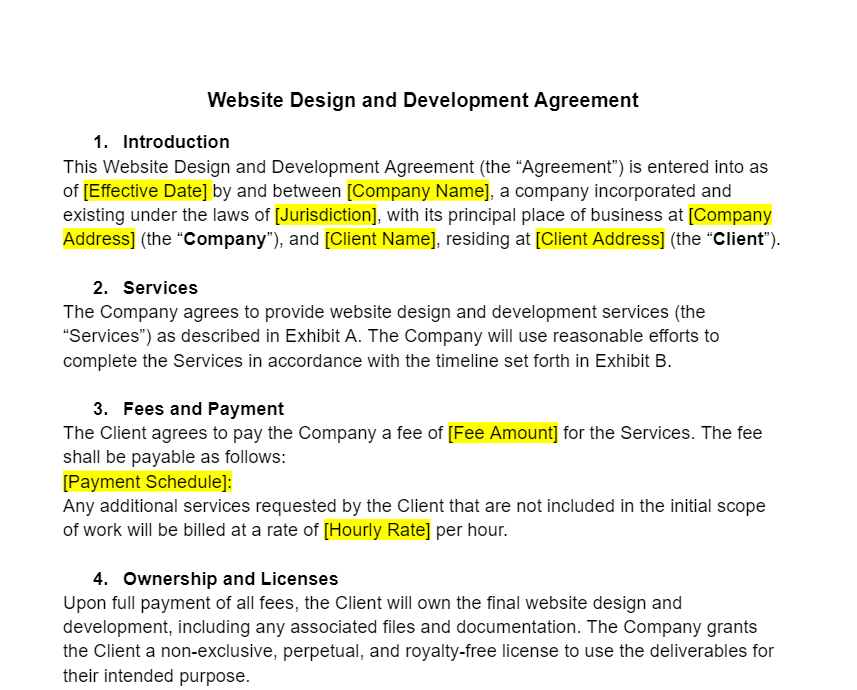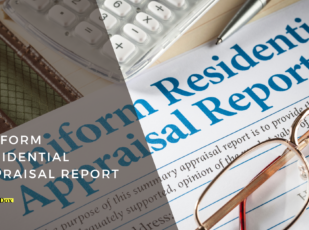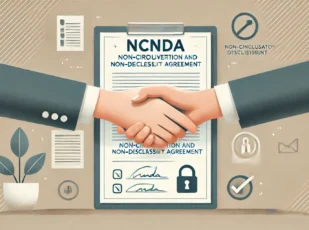
Website Design and Development Contract Template
20 Downloads
Commercial, Employment, IT and Media
February 17, 2025
Sayantani Dutta
The website represents the penultimate digital asset a company can own. While outsourcing its design and development to independent contractors has its advantages, there are many risks that outweigh the benefits of the arrangement without terms being agreed upon in a formal, well-written legal document.
Below, we investigate key clauses and provisions to include in a design and development services contract that help businesses and development teams steer clear of pitfalls, reduce risk, and ensure project success.
What is a Website Design and Development Agreement?
A web design and development agreement is a legally binding document representing the relationship between a developer and the client. This agreement spells out project expectations for deliverables, pricing, timelines, and so on. This agreement governs the responsibilities of each party and is a tool for mitigating risk and maintaining a smooth working relationship.
Website Design and Development Agreement: Key Components and Importance
A website development agreement, also referred to as a web development contract, is an agreement between a web developer and their client. This contract outlines expectations, limits ambiguity, and addresses various aspects of the development process, from project scope to delivery timelines.
Key elements in this agreement comprise the following provisions.
- The scope of the development services; descriptions regarding web pages, features, and functionality.
- Project timeline, including dates of commencement and expected delivery date.
- Payment structure: flat fees, hourly rate, or milestone-based.
- Rights and warranties relating to the final website, including but not limited to, ownership and intellectual property.
- Terms for revisions and changes to the project scope.
- Disclaimers of liability due to uncontrollable events or results.
- Indemnification provisions for both parties, in case of any claims.
- The conditions surrounding the termination of the agreement.
By addressing these provisions clearly, the agreement creates a strong foundation for collaboration and helps prevent misunderstandings.
Website Design and Development Agreement—Phase 1: Naming of Parties and Legal Provisions
Let’s look at each of the provisions in detail to give you a well-rounded view of what to include in the document.
Parties’ Information
The agreement should start with the provision of accurate contact details for both the client and the developer. This section usually outlines the names, addresses, and contact information for both parties.
Addresses for Notices
Both parties’ registered addresses should be noted for receiving notifications or communications relevant to the agreement. This step provides a clear point of contact on both sides.
Written Notice Requirement
The agreement may stipulate that formal communications between parties with respect to the project are sent in writing. This requirement maintains transparency and keeps accurate records of interactions.
Attorney’s Fees Clause
This section provides for the event of legal action and which party is responsible for the attorney’s fees and related expenses. By making this clear from the outset, the agreement avoids confusion in disputes.
Confidentiality and Warranties
Confidentiality provisions prevent the disclosure of sensitive information during the design and development process. This includes protection of client data, trade secrets, or proprietary tools used by the developer.
The agreement should also state warranties about the final website design and execution. It may provide guarantees that the website will perform as intended when delivered or list responsibilities in the event of technical issues arising after the website is launched.
Termination and Severability
Include the terms of termination of this agreement by stating the conditions under which either party will be legally and rightfully allowed to end the relationship. For example, the contract may allow termination if payment obligations are unmet or if project deadlines are missed without valid justification. The entire agreement and severability clauses ensure that when one part of the agreement is invalidated or unenforceable, the remaining portion of the contract will still remain intact and valid.
Website Design and Development Agreement—Phase 2: Outlining Services
This phase of the website design and development agreement clearly defines the services, expectations, and responsibilities of both parties. This document becomes a valuable tool in guiding the project and preventing disputes through careful planning and detailed provisions. It also provides a legally enforceable basis for the business relationship.
Scope of Work and Deliverables
A well-defined scope of work limits misunderstandings regarding what services will be covered and what is not within the scope of the agreement. The scope of work for the web development contract should detail the deliverables, i.e., tasks, functionalities, and features the developer will deliver, such as design, e-commerce functionality, content creation, or other additional services tied to the project.
It is recommended to specify the Scope of Work on a separate page. This document is signed by the client as an agreement to the deliverables outlined in the contract and assists in settling disputes over project expectations and deliverables.
Customizing the Agreement for Your Project
It’s beneficial to create a flexible framework within the agreement to accommodate the unique needs of each design and development project. A well-structured contract can attach “Exhibit A;” outlining project-specific details, such as the number of web pages, preferred technologies such as HTML, and any other project deliverables. These details accommodate changes without rewriting the contract from scratch, facilitating the handling of updates or revisions during the course of the project.
Following Services
A section addressing post-development services must be established to set expectations outside the initial scope of work. This provision includes responsibilities such as ongoing maintenance, website updates, troubleshooting, or other forms of technical support the client may require after the delivery of the project.
Exclusive Ownership
This section asserts that all rights, title, and interest in and to the deliverables, including its components, will exclusively vest with the client. This agreement will provide written evidence of the client’s ownership of the website and its components so there is no misunderstanding about who owns the intellectual property.
Timeline and Milestones
Timelines and milestones are important in effective project management. The agreement should include a schedule listing deadlines and checkpoints throughout the development process. Identify metrics tracking project progress for more accountability on both the client and the developer side of the agreement.
Payment Terms
Clearly define the terms of payment to ensure transparency and prevent disputes. Include the total cost of the project, any itemizations requested by the client, the method of payment, and the due dates for payments either by installments or upon completion of project milestones. Mention any additional fees charged, including attorney fees, in case of dispute resolution. A clear remuneration plan nurtures trust between parties and simplifies the transaction process.
Perks
Any fringe benefits the developer is entitled to, such as health insurance or retirement contributions, should be clearly spelled out in this section of the agreement. Be very clear in stipulating that such benefits are entirely discretionary and do not constitute an obligation on the part of the client.
Final Approval
The agreement should include the procedure for obtaining the client’s final approval of the website before launching. This step provides the client with an opportunity to go through and confirm that all the features of the project meet their expectations. Final approval is a critical checkpoint that formalizes the transition of the website from development to execution.
Licensing Intellectual Property
The agreement should outline any third-party components or licenses used in the project, specifying the rights and restrictions tied to these elements. This transparency helps both parties understand the licensing requirements for external resources.
Feedback and Dispute Resolution
Outline how parties can bring suggested changes to the scope, timelines, or deliverables of the project and the processes to be followed in negotiating these modifications.
Independent Contractor Relationship
The agreement should point out that the developer is an independent contractor and not employed by the client. This differentiation clearly draws the line for the responsibilities of each party, removing confusion over issues of compensation for benefits such as health insurance, paid leave, or other employee entitlements. It helps ensure that the relationship is properly defined so that both parties can focus on their respective obligations without confusion with regard to employment status.
Web Hosting and Additional Services
If web hosting services form part of the project, the details must be specified in the agreement. These details include, but are not limited to the kind of hosting, the period, costs involved, and other related hosting responsibilities the developer or client should bear.
If the developer is expected to manage the hosting service, this should be clearly documented in the agreement. This finality ensures both parties have a mutual understanding of the hosting requirements and where the liability for hosting resides.
Make Sure the Agreement Names a Legal Jurisdiction
For those familiar with contract law, specifying a legal jurisdiction is an obvious requirement. Unfortunately, most web designers write their own web design contracts with this information omitted; such omissions usually lead to a lot of complications when disputes do come up.
In the applicable law section of your agreement, clearly indicate the country or state governing law for the contract. It’s a good idea to include that any disputes will be settled under the jurisdiction of your home state, as this makes proceedings easier and negates the possibility of litigation in unknown courts.
Under current U.S. law, lawsuits arising between parties with claims of over $75,000 may be filed in federal court within the district where either party resides. You may want to add an alternative dispute resolution clause. For example, it could be dependent upon binding arbitration pursued with the help of a neutral third party in which costs are shared equally between the parties.
Arbitration is normally faster, much less expensive than litigation, and more collaborative; preserving your professional relationship with the client and the viability of the project.
Format the Agreement So It Doesn’t Intimidate Prospective Clients
Long and complicated agreements can be frustrating to roll out during the onboarding process. You don’t need web design contracts that are nine pages long and give your team headaches. The clients may find its length overly formal or intimidating.
Many of these agreements require a great deal of time to walk through each section and, if sent electronically, often come back with questions or edits. This process delays the launch and adds a layer of unnecessary complexity, killing project momentum.
All you need is a one-page template in a concise format to simplify the process, reduce client hesitation, and get underway without any delays.
Download a Website Design and Development Agreement Template from FreshDox
Sign up for a free trial of a Basic or Premium account at FreshDox and get immediate access to our web design contract template for your next project. Protect your interests and edit our design and development contract template to your needs. Start your free 7-day trial of our platform today and browse our catalog of professionally designed templates for business.
Popular searches:
- Website Design and Development Contract Template pdf
- Website Design and Development Contract Template sample
- Website Design and Development Contract Template download
- Website Design and Development Contract Template format
- Website Design and Development Contract Template template
- Website Design and Development Contract Template word
- Website Design and Development Contract Template free
Related Templates
Discover more templates that align with your needs and preferences.

Ready to Sign Up?
Sign up for FreshDox.com’s 7-day trial and discover why so many individuals and businesses trust us for their legal document template needs.
- Cancel any time
- 7-day free trial
- From 300+ Customer Reviews
















